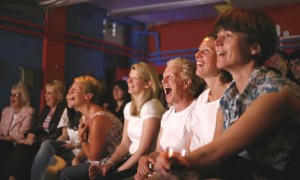 The Stage reports: “Study finds attending plays feels as good as a pay rise”. The study was carried out at the LSE, funded by the UK Department for Culture Media & Sport.
The Stage reports: “Study finds attending plays feels as good as a pay rise”. The study was carried out at the LSE, funded by the UK Department for Culture Media & Sport.
The research paper itself is an excellent piece, well-placed in the current scholarly literature on determinants of (self-reported) well-being, clearly presented, and always careful to note the limitations on what we can draw from its findings. I think where we most need to be careful is in how we interpret the research.
The Stage writes:
People who attend plays have a level of wellbeing equivalent to the amount of happiness derived from a £1,000 annual income increase, new research on the social impacts of culture has found.
The publication, Quantifying and Valuing the Wellbeing Impacts of Culture and Sport, has found that audience members who watch at least two plays a year report personal wellbeing that can be valued at £83 per month.
What does this actually mean? Can we send more people to plays and make them feel happier? It looks like a good value: public distribution of theatre tickets would be much more cost-effective than sending people cash, if these numbers are to be believed.
But that’s not what the research actually says. The study takes individual survey data on individual self-reported well-being, plus a host of economic and demographic variables, including attending or participating in arts or sports. Through relatively simple regression analysis, it then looks at which variables are correlated with more reported happiness. These studies must always be read cautiously, since happiness is such a complicated thing. For example, other things equal, a higher income that was achieved only recently is likely to correlate with higher reported happiness than the same higher income that was granted years ago – our happiness levels tend to revert (at least partly) back to their original levels after we have become accustomed to higher incomes (and even that is complex – an income rise out of poverty has a much bigger effect on well-being than an income rise within the middle or higher income levels).
Once the regression coefficients have been found, we can then compare across variables. If people who attend theatre, other things equal, are happier, and people with higher incomes, other things equal, are happier, we can ask “what increase in income is associated with the same higher level of happiness as attending the theatre?” And that is where we get numbers like the £83 per month.
Why be cautious? Two reasons:
First, the results suggest that theatre attendees are happier, other things equal. (It also suggests that people who regularly perform music are unhappier, although I haven’t read much about that yet). But it is a minority of people who attend the theatre, and they are, obviously, the people who like going out to a play. There is no evidence that people who are not attending the theatre would be made happier if they would begin attending – we don’t know that. In fact we might even speculate that the key policy implication of the study is not to get more of the current generation out to the theatre, but to focus on cultivating an enjoyment of the theatre in the young, so that they have something that might give them pleasure later.
Second, we need to be careful about how we place the study. Newspapers rely on news. And so the science and arts pages of newspapers have daily stories “A new study has found that XYZ!” But this is but one study, with a specific data set, collection of explanatory variables, measure of well-being, and regression technique. It’s a very good study, but it is just one study. When we have more and more such studies with different data, variables, methods, and they all point towards the same conclusions and magnitudes, then we can start to gain some confidence that we know something about this. At this point economists are still at odds on calculating what ought to be the most straightforward of questions: how much is happiness affected by income? It’s a lively area of research, but still with a long way to go.

[…] in income is associated with the same higher level of happiness as attending the theatre?’ wrote Michael Rushton, director of arts administration programs at Indiana University in Bloomington, for ArtsJournal. […]